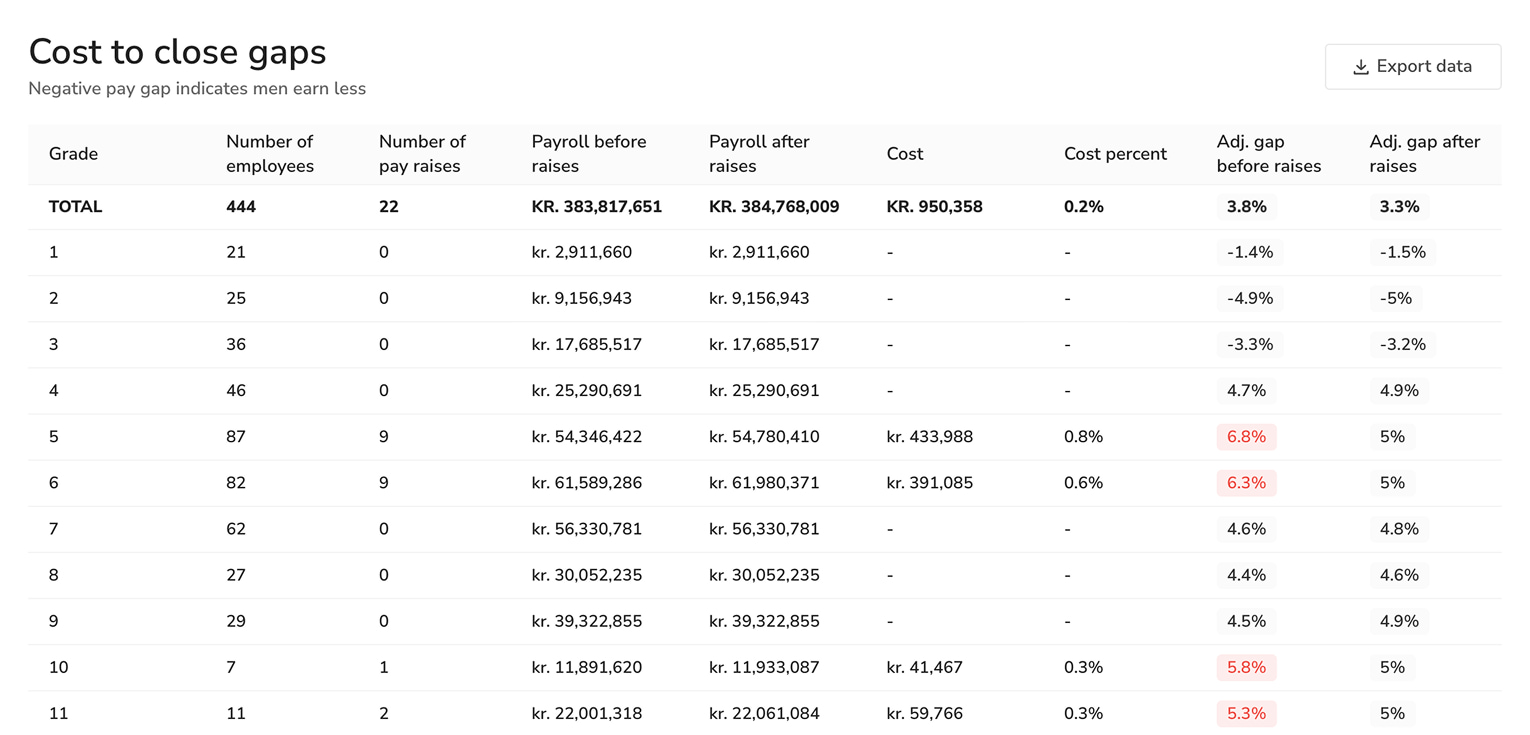Close pay gaps
Calculate the most cost-effective adjustments to eliminate pay gaps fairly.

Close pay gaps efficiently with AI-powered optimization. Our algorithm calculates the exact pay adjustments needed to eliminate gaps within your target parameters or budget constraints.
Close by target or budget
Choose the strategy that fits your organization's needs: target-driven to fully close identified gaps regardless of cost, or budget-driven to achieve maximum equity improvement within financial constraints.
Customize further with constraints like maximum raise percentages, grade exclusions, or individual exemptions. Cap salary increases, exclude senior grades, or exempt specific employees to ensure your remediation plan fits organizational policies and practical constraints.

Optimized for cost and fairness
Our algorithm prioritizes employees who are most significantly underpaid within underrepresented groups. By addressing the largest gaps first, every adjustment dollar has maximum impact while maintaining fairness across all increases.
This means faster compliance, lower costs, and demonstrably fair outcomes. Every remediation euro works harder while creating a transparent process you can confidently defend to auditors and employees.
Transparent and reproducible
Export detailed model documentation and validation guides to ensure complete transparency in your remediation process.
Share methodology details with auditors, legal teams, or regulatory bodies to demonstrate the scientific rigor behind your pay adjustments.
This comprehensive documentation creates a defensible audit trail that builds stakeholder confidence and protects your organization against potential legal challenges.
Additional Resources
Calculate fair pay
Calculate equitable pay ranges for promotions and new hires
Validate pay grades
Identify and correct outliers with our AI powered grade review tool.
Close Pay Gaps
Close pay gaps with confidence using our recommendations engine.
Frequently Asked Questions
What's the difference between target-driven and budget-driven remediation?
Target-driven remediation focuses on completely eliminating all identified pay gaps, regardless of cost. You set your equity targets - like closing all gaps above a certain threshold - and the algorithm calculates exactly what it takes to get there. This approach prioritizes full compliance and maximum fairness.
Budget-driven remediation works within your financial constraints to achieve the greatest possible equity improvement. You set a remediation budget, and the algorithm determines how to allocate those funds for maximum impact - typically by addressing the largest gaps first within underrepresented groups.
Most organizations choose target-driven remediation because the EU Pay Transparency Directive mandates closing gaps to 5% - making complete elimination a compliance requirement. Budget-driven remediation is typically used when immediate full compliance isn't financially feasible, helping you maximize equity improvements within current budget constraints while planning for full compliance.
How does the algorithm decide who gets raises and how much?
The algorithm prioritizes employees who are most significantly underpaid within underrepresented groups, addressing the largest gaps first for maximum impact. It calculates the precise adjustment needed to bring each employee to fair pay levels while considering your constraints like maximum raise limits or grade exclusions.
The system balances multiple factors - the size of the individual gap, the employee's group representation, and your remediation strategy (target or budget-driven). This ensures every euro spent has maximum equity impact while maintaining proportional and defensible adjustments across your workforce.
All calculations are transparent and reproducible - you'll see exactly why each employee was prioritized and how their adjustment amount was determined. The algorithm optimizes for both cost efficiency and fairness, so you're not overpaying to close gaps or creating new inequities in the process.
Curious to see how the prioritization would work with your specific workforce data? Let's run through the algorithm with your employee information in a demo.
Can we set limits on individual raise amounts or exclude certain employees?
Absolutely. The algorithm accommodates various business constraints to ensure your remediation plan fits organizational realities. You can set maximum raise percentages to maintain budget control, exclude specific grades like senior leadership from automatic adjustments, or remove individual employees who have unique circumstances - such as recent promotions or pending performance reviews.
These constraints are built into the optimization, so the algorithm works around them to still achieve maximum equity impact. For example, if you cap raises at 15%, the system will prioritize employees who can be brought to fair pay within that limit, ensuring your budget delivers the greatest possible improvement.
The flexibility means you can balance regulatory compliance with practical business considerations while maintaining an optimal and defensible remediation strategy.
Can I see exactly which employees need raises and by how much?
Yes, absolutely. Fairfox provides a detailed breakdown showing exactly which employees need pay adjustments and the precise amount each person should receive to close gaps to your target level or within your budget.
You get a clear table listing each employee who needs an adjustment, their current pay, recommended new pay, and the increase amount. This can be exported directly to Excel for easy implementation with your payroll system.
This transparency lets you review every recommendation before making changes, ensuring you understand exactly how your budget will be allocated and which specific gaps are being addressed.
How much can proper job grading save on remediation costs?
roper job grading can reduce your remediation costs by up to 60%. Here's why: many apparent "pay gaps" are actually employees who are misclassified in the wrong grades.
When someone is in the wrong grade, their pay gap gets "fixed" with a salary adjustment when the real solution is simply moving them to the correct grade. This means you're spending money on raises that don't actually address bias - they just mask classification errors.
By identifying and correcting grade misclassifications first, you ensure pay adjustments are only made where there's genuine evidence of inequity. Our optimization algorithms account for both proper grading and targeted adjustments, so every euro of your remediation budget delivers maximum equity impact.
The actual cost to close your specific gaps depends on your current equity position, workforce composition, and remediation strategy - but the savings from proper grading are substantial.


